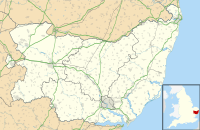Eye Castle facts for kids
Quick facts for kids Eye Castle |
|
|---|---|
| Eye, Suffolk, Suffolk, England | |

Eye Castle, with 11th century motte and bailey, and Victorian ruin
|
|
| Coordinates | 52°19′13″N 1°09′01″E / 52.3202°N 1.1503°E |
| Type | Motte and bailey, with later Victorian addition |
| Site information | |
| Condition | Ruined |
| Site history | |
| Materials | Flint |
Eye Castle is an old castle in the town of Eye, Suffolk. It's a type of castle called a 'motte and bailey'. This means it has a big earth mound (the motte) and a walled area (the bailey). The castle also has a large addition from the Victorian times.
It was built soon after the Normans took over England in 1066. Sadly, the castle was attacked and mostly ruined in 1265. Later, in 1844, a man named Sir Edward Kerrison built a stone house on the castle mound. This house also fell apart and was called Kerrison's Folly.
The Story of Eye Castle
Early Days: From Normans to Barons' War
Eye Castle is a 'motte and bailey' castle. It was built by William Malet when William I was king. William Malet died fighting a hero named Hereward the Wake in 1071.
The Malet family also owned a large area of land called the 'Honour of Eye' around the castle. They also had a deer park nearby. The castle's motte (mound) is about 49 meters wide and 12 meters high. The bailey (walled area) is about 122 meters long and 76 meters wide.
Eye Castle is special because it was one of only two castles mentioned in the Domesday Book in 1086 that made money for its owners. This was because it had a market inside the castle bailey. The castle's market competed with the market run by the Bishop of Norwich in Hoxne.
William Malet's son, Robert, was sent away from England. After he died in a battle in 1106, King Henry I took Eye Castle for himself. In 1113, Henry gave Eye to his favorite nephew, Stephen of Blois.
Stephen became King of England in 1135. He first gave the Honour of Eye to one of his helpers, William of Ypres. Then he gave it to his son-in-law, Hervey Brito. Later, in the 1140s, Stephen gave the lands to his second son, William. William was young, so Stephen's trusted helper, William Martel, managed the lands for a while.
During this time, a civil war called the Anarchy happened between King Stephen and Empress Matilda. This war lasted from 1138 to 1154. Much of the fighting took place in East Anglia. A powerful family, the Bigods, led by Hugh Bigod, tried to gain more power. Eye Castle was not a main battleground in this war.
After becoming king in 1154, Henry II wanted to make the king's power strong again. Hugh Bigod had become very powerful in East Anglia. He was the Earl of Norfolk and owned four big castles: Framlingham, Bungay, Walton, and Thetford. To reduce Hugh's power, King Henry took his castles in 1157.
King Henry also saw Stephen's son, William, as a possible threat to his throne. So, he took Eye Castle from William at the same time. William died in 1159, which meant Henry officially owned Eye Castle.
Hugh Bigod then joined a rebellion by Henry's sons in 1173. Eye Castle was attacked by Hugh Bigod in 1173. The attack failed, but the castle needed to be rebuilt. Two square towers were added to the north side of the inner bailey in the late 1100s. This might have happened around the same time as Framlingham was built.
The castle was protected using a system called 'castle-guard'. This meant that local lands were given to smaller lords. In return, they had to provide knights and soldiers to defend the castle.
In 1265, during the Second Barons' War, the castle was attacked and ruined. After this, it was mostly left empty.
Later Years: From Ruins to Folly

By the 1300s, Eye Castle was mostly in ruins. However, some parts were still used as a prison. Even though the castle was ruined, the local lands that used to provide soldiers for 'castle-guard' still paid money to the castle's owners for many years.
Between 1561 and 1562, a windmill was built on top of the motte. In the early 1600s, the deer park around the castle was divided into fields, just like many other old parks in Suffolk.
In the 1830s, a workhouse and a school were built inside the castle bailey. In 1844, the owner, Sir Edward Kerrison, removed an old windmill that was on the motte. He built a house there instead.
Kerrison had the house built for his batman (a military assistant). This batman had saved Kerrison's life at the Battle of Waterloo in 1815. The house looked like a 'shell keep' (a type of castle tower). It was made of flint stone. It had living areas built into its walls on the south and west sides.
The building eventually fell into ruins. It was damaged by strong winds in 1965 and collapsed even more. It is now sometimes called Kerrison's Folly. The original castle mound and some stone pieces are still there. The site is a scheduled monument and a Grade 1 listed building, which means it's a very important historical site.



